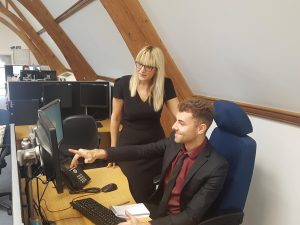Proving an accident was not your fault
Published on in News & InsightsAccidents differ in severity, but assuming nobody is hurt, the next most important thing is gathering evidence which can be used to prove your version of events if you believe an accident was not your fault.
While it is good to be optimistic about human nature, within our claims department we are often told a third party apologised at the scene, accepting they were the cause of an accident, only to find out – when we speak with their insurance company – they are disputing liability.
This is understandably very frustrating for our clients, when they know, without a doubt, that they (or their drivers) weren’t to blame for the accident.
Sometimes, the areas of damage on the vehicle will support the true circumstances. For example, if you are driving along a straight road and a third party emerges from a junction because they didn’t check the road was safe to join, the damage is highly likely to back this up. Similarly, the balance of probabilities says that, if two vehicles have an accident leading up to a junction and one has rear damage, the party at the rear is to blame (unless there’s a likely reason for the driver at the front to reverse).
Usually, on cases like those above, liability is admitted by the fault party, or is easily proven if not. However, we regularly see disputes on collisions such as the below, and often liability gets settled on a 50-50 basis (which is not a fair reflection of the accident):
- Narrow roads
- Roundabouts
- Dual carriageways and motorways, where one party is alleged to have changed lanes
- Car park collisions
Our experience shows that around 90% of claims with the above circumstances get argued. With this being said, it would be wise to expect a third party to deny fault for their own interests (not wanting their insurance premium affected or a fault claim recorded against their name). In these circumstances, you will need evidence to prove the accident was not your fault.
Witnesses, who are independent (i.e. not known to either driver) can be a form of evidence, but often people are too busy to stop and provide their details, or some are hard to get a hold of after the accident. Sometimes, CCTV cameras will be available (such as in a car park), but again these can’t be relied upon in most cases.
The one thing anyone can do to increase their chance of proving what happened in an accident is to invest in a dash-cam. These can be picked up for under £50 now, and could end up saving hundreds or thousands on premiums. If you were pulled over on a narrow road, and the third party driver hit into your stationary vehicle, the dash-cam would be very likely to prove this (assuming the incident is in view of the camera). Without the camera, it won’t be possible to prove what really happened and a claim like this would usually end up with blame being apportioned to both parties.
Beyond proving who was at fault on claims where there is a dispute, dash-cams can also be useful in catching drivers that attempt to flee after a collision. Fully HD cameras are available within the £50 price bracket and will allow the user to pause the footage and make out a vehicle registration plate, even if the vehicle is driving off at high speed. It’s also possible that dash-cams can increase the chances of fraudulent injury claims being kicked out as a camera can allow injury claims handlers to decipher whether an injury would be considered possible.
Ultimately, for the small amount they cost, you would do well to consider making the investment.
At Hugh J Boswell we have can recommend the appropriate dash-cam technology. Furthermore we can establish whether your insurance company might be willing to support the installation of cameras in to fleets of vehicles as a risk management measure. Speak to us to see if we can help. We’re available on 01603 626155.
